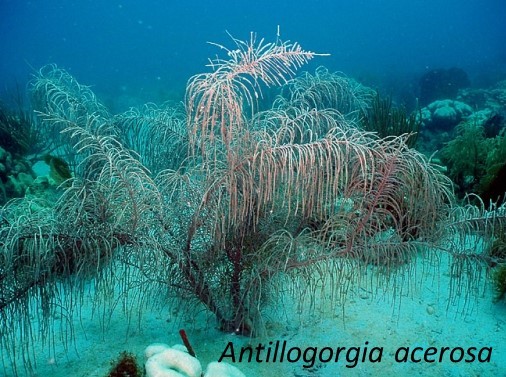
Family: Gorgoniidae
Common Name(s): Common sea plume
Colony Form: Pinnate, plumose; often resembles ostrich plumes; to over 2 m tall.
Axis: Cylindrical
Branches: Pinnules flimsy, very flexible, oval in cross section, not tapered to tips, not paired on opposite sides of branch, regularly spaced, 1-3 mm wide, 10-20 cm long, longest of any Antillogorgia species. Some specimens form long, drooping, widely spaced pinnules along the stem.
Apertures: Round to slit-like, usually smooth, restricted to row along opposite narrow sides of pinnules.
Mucus: None
Color: Purple to beige; dries brown, beige, tan, pale yellow.
Sclerites: Polyp armature: delicate flat rods. Body wall: scaphoids (curved sclerites) weakly curved, with convex surface smooth or finely spiny, <0.18 mm long; spindles acute.
Habitat: On reefs and hard bottoms in 1-30 m depth.
Distribution: Bermuda, South and West Florida, Bahamas, Gulf of Mexico, Caribbean Sea.
Notes: Finely sandpapery to the touch. This species is the tallest gorgonian in the western tropical Atlantic. Off Cartagena, Colombia, it is commonly harvested as raw material for handicrafts. Year-long growth studies at two different reefs revealed that most growth was due to rapid elongation of the main (‘mother’) branch and production of daughter branches from the same mother branch or a few of them. Some small colonies doubled in size in a year. Absolute branch growth rate correlated weakly with size, with no significant relationships between branch size and percent growth. Although the pinnate branching pattern in A. acerosa is similar to that in A. elisabethae and A. bipinnata, it produces taller colonies because the main stem grows more rapidly, augmenting exposure to light and higher fluxes of suspended food in the benthic boundary layer. Colonies clipped for harvest exhibited clear signs of regeneration, even in cases where only the holdfast remained. A. acerosa appears to resemble other Antillogorgia species in that regenerating colonies may grow faster than intact ones. Williams and Chen (2012) transferred all Western Atlantic species of Pseudopterogorgia to the genus Antillogorgia. The flamingo tongue gastropod, Cyphoma gibbosum, preferentially consumes axial tissues near the base of colonies.
Similar Species: Antillogorgia rigida; Antillogorgia elizabethae







